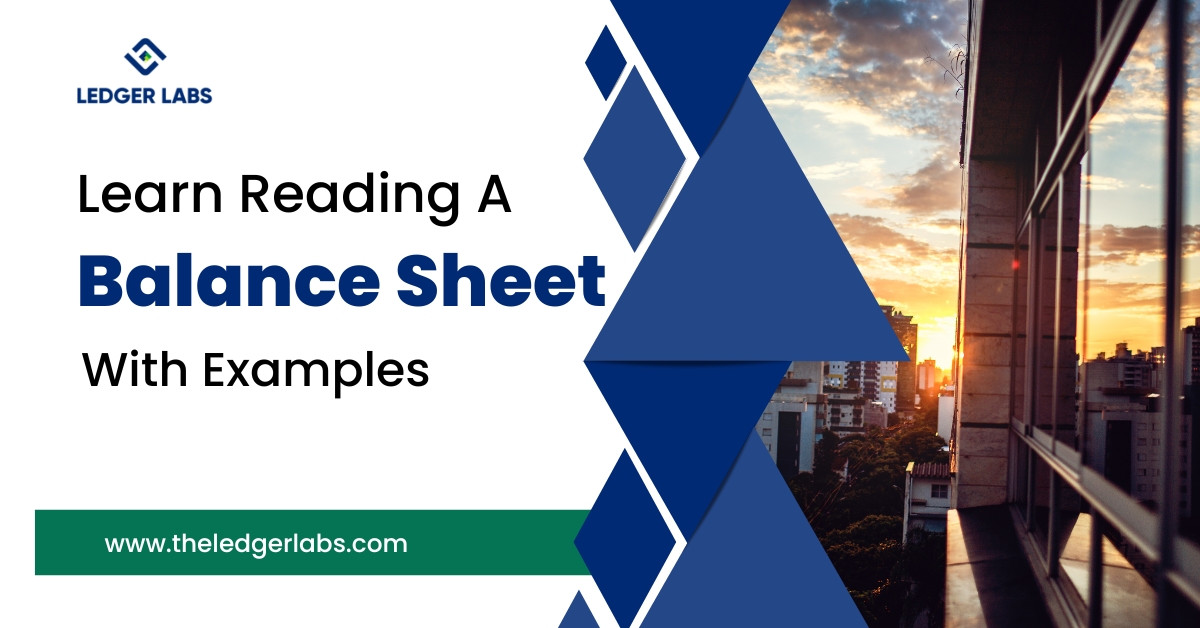The performance of any business is assessed based on the records presented in the financial statements that they maintain. Three major financial statements that businesses must maintain are the income statement, statement of cash flows, and balance sheet. Of them, the balance sheet is the most prominent one as it helps stakeholders check the present financial health of the companies. While maintaining it with accuracy is difficult, reading a balance sheet properly is even tougher.
What Is A Balance Sheet?
As already stated above, a balance sheet is one of the most useful financial statements that a company maintains to record the flowing finances. It is a document that displays the worth of the company or its book value as of the reporting date, which is the financial date on which the data is recorded.
A business balance sheet helps both the internal and external stakeholders of the company to check the growth and performance of the firm. It lets the business owners have a detailed view of the assets and liabilities and understand how balanced the cash outflow and inflow are. Based on the same, they make effective strategic business decisions.
Next, the financial details in the balance sheet become an analysis tool for potential investors who try to learn about the business prospects and assess its growth per the details covered within. Depending on their assessment and the growth potential of the company, they decide whether to invest in the firm or skip it.
Components
Reading a balance sheet requires a few necessary financial accounting skills. For you to start with, knowing the components that help generate this financial statement is a must. Three major elements make up this balance sheet – assets, liabilities, and shareholder’s equity.
Assets
Assets refer to whatever a company owns of a significant value. These are accounts that involve cash inflow and can either be current assets or long-term assets. Current assets include the assets that are currently active or have a life span of less than a year. On the contrary, the assets with ownerships that exceed the term of one year are long-term assets.
While the accounts related to accounts receivables, inventory, and cash in balance account fall under the current assets category, property, plant, and goodwill are labeled as long-term assets.
Liabilities
Liabilities refer to the debt or any financial burden that the company faces as of the reporting date. Like assets, these are also classified into current and long-term categories. The current liabilities are the financial burden that companies need to take care of within a year, while long-term liabilities are debts exceeding that tenure.
While a current portion of long-term debt or accounts payable are current liabilities, long-term debt, and the rent to be paid for a long-term fall under the long-term liabilities category.
Shareholder’s Equity
Shareholder’s equity for a corporation is the same as the owner’s equity for a firm running as a sole proprietorship entity or partnership venture. It is the total net worth of a business, which includes the initial amount of money that shareholders invest in a company. It includes everything from paid-up capital to retained earnings to contributed surplus.
While the assets take the debit side, the liabilities are recorded as a credit entry for the company.
Strengthen Your Organizational Backbone

How To Read A Balance Sheet?
To understand reading a balance sheet, you must know how everything works in the financial document. The companies record assets, liabilities, and shareholder’s equity collectively in the same sheet. If only the information tally in the balance sheet tally, it is considered accurate. In case any discrepancy is observed and the records mismatch, the entries are declared incorrect, null, and void.
The balance sheet, however, is tallied per the following equation:
Assets = Liabilities + Shareholder’s Equity
If the details in the balance sheet don’t satisfy the equation, mismatches are detected and even frauds are easily identified. And this is what makes a balance sheet an even more important document for any firm to maintain.
Generating A Balance Sheet
The balance sheet example below helps us understand how it all works.
A company spends $160,000 in buying new machinery as it receives a bulk order for which the existing machinery won’t be sufficient. It makes a down payment of $60,000 and applies for a bank loan of $100,000. In such a scenario, the loan is considered a long-term liability with the rest of the details as follows:
| Assets | Liabilities | ||
|---|---|---|---|
| Cash | $1,000 | Accounts Payable | $8,000 |
| Accounts Receivables | $10,000 | Credit card dues | $5,000 |
| Inventory | $4,000 | Long-term liability | $100,000 |
| Machinery | $160,000 | ||
| Total Assets | $175,000 | Total Liabilities | $113,000 |
| Shareholders’ Equity | $62,000 |
In the above example, as the value of assets equals the sum of the liabilities and shareholders’ equity, the balance sheet is said to have accurately calculated the company finances. However, If the same doesn’t tally. It indicates mismatches and even scams and frauds in the firm.
Post-Generation Of The Balance Sheet
Once the users excel reading a balance sheet, it will help them figure out certain ratios knowing which can help them make a better and clearer analysis of the financial health of any business. The metrics that could be derived from the balance sheet figures to further help in assessing a business’s position in the market include:
- Debt-to-Equity Ratio: It is obtained by dividing the total financial burden that a company has by the equity that is derived for balancing the financial figures. If the debt is less than the equity. It will result in a lower ratio, which indicates the better financial health of a firm. However, if it’s vice-versa, it becomes a reason to worry.
- Working capital/Liquidity: The balance sheet lists the capital that the company has and how capable it is to pay back in case of a financial crisis. In short, this is assess by investors or lenders to check how likely the firms are to default. This way, they analyze the risks associated with the deals.
- Returns: If the income is more than the liability, the returns are assured. The balance sheet helps investors get a clue on how much returns they should expect if they invest in the company assets.
Final Words
If you want to make your business finances easy to understand, read and interpret, a balance sheet can help you. After knowing everything from reading a balance sheet to learning how the data mention there could use further. It would surely be easy for you to use the financial statement in the best possible way. So, prepare it, manage your finances, and keep a check against fraud through your balance sheet.
Are you still struggling to read your balance sheet? Consult our professional accountants and bookkeepers today. They will not only help you learn to read and interpret a balance sheet properly, but also let you understand how to prepare it with utmost accuracy.







